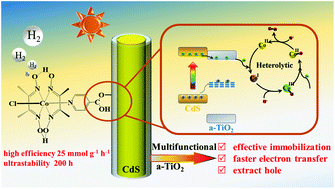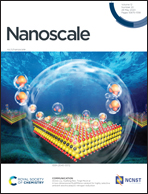Amorphous TiO2 as a multifunctional interlayer for boosting the efficiency and stability of the CdS/cobaloxime hybrid system for photocatalytic hydrogen production†
Abstract
The construction of both highly efficient and stable hybrid artificial photosynthetic systems comprising semiconductors as photosensitizers and abundant metal-based molecular complexes as cocatalysts for photocatalytic H2 generation remains challenging. Herein, we report an effective and stable CdS/cobaloxime hybrid system prepared by inserting an amorphous TiO2 (a-TiO2) interlayer with adjustable thickness and by covalently-surface-attaching molecular cobaloxime catalysts. This hybrid system displayed outstanding photocatalytic H2 production and reached a maximum rate of ∼25 mmol g−1 h−1, which was ∼20.8 times that of pure CdS and 1.7 times that of the CdS/cobaloxime system without an a-TiO2 interlayer (CdS/Co). More importantly, 6 nm a-TiO2 uniformly coated CdS nanorods (CdS NRs) exhibited exceptional 200 h long-term catalytic behaviour under ≥420 nm visible light irradiation. However, the H2 production performance of the CdS/Co hybrid system decreased significantly over 10 h. Density functional theory (DFT) calculations indicated that the a-TiO2 surface can provide abundant bonding sites for the effective immobilization of molecular catalysts. Moreover, Mott–Schottky electrochemical measurements and femtosecond transient absorption spectroscopy revealed that the a-TiO2 interlayer had favourable band levels that could fasten the photoexcited electron transfer from CdS to molecular cobaloxime and could extract holes with intraband electronic states generated by defects, thus prohibiting CdS photocorrosion and improving the stability of the hybrid system. This study proposes a strategy for designing multifunctional interlayers for the effective immobilization of molecular catalysts, beneficial regulation of photoinduced charge carriers, and improvement of the stability as well as facilitation of the construction of artificial photosynthetic hybrid systems with high efficiency and durability.



 Please wait while we load your content...
Please wait while we load your content...